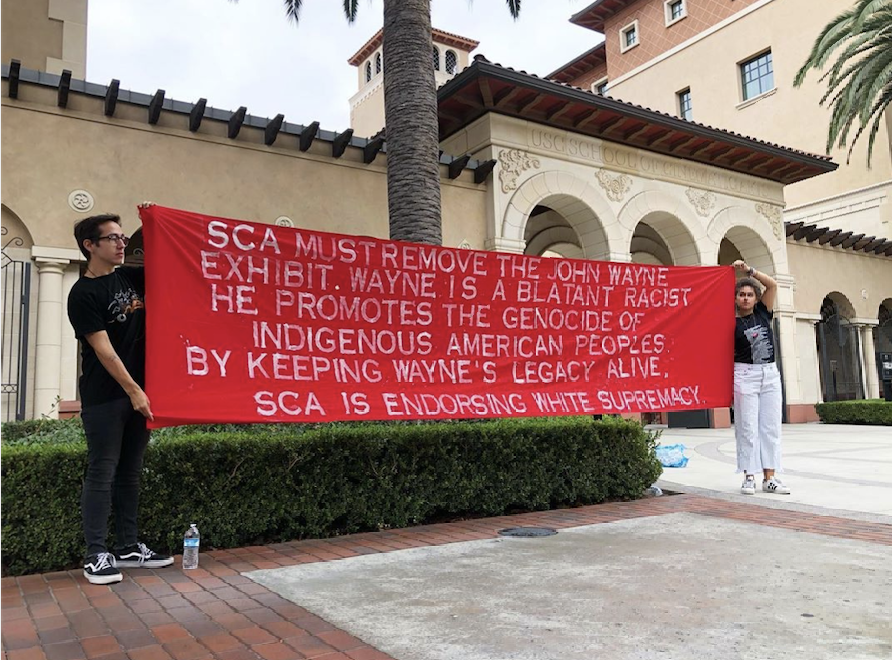Students discuss controversial SCA John Wayne exhibit

(Photo from Eric Plant | Instagram)
The School of Cinematic Arts will decide if its John Wayne exhibition will be removed by the end of this semester, an SCA official announced at a Wednesday discussion hosted by the school’s Council for Diversity & Inclusion.
Nearly 50 students attended the discussion prompted by a protest from two SCA students who held a banner in front of the Cinema Complex, calling for the removal of the exhibit, which they said supports Wayne’s legacy of endorsing white supremacy and the removal of indigenous people.
SCA Interim Assistant Dean of Diversity and Inclusion Evan Hughes began the event by explaining the Council’s efforts to approach the controversy surrounding the exhibit, which features movie posters and memorabilia honoring the alumnus and football player’s film career. He also said that the conversation would provide recommendations to SCA administration for future action related to the exhibit.
“This has been an issue that the [Council] has debated over a long period of time,” Hughes said. “At the end of last semester, we were trying to figure out different options for paths to move forward with this particular exhibit because not even students, but faculty that have walked by the exhibit said that we don’t think this accurately represents film history as it should probably should be represented.”
Some students opposed the exhibit’s possible removal, stating the actor contributed to the Western genre in film. They said removing his legacy would erase an aspect of filmmaking history that many students strongly connect with. During the discussion, students were allowed to remain anonymous to create a safe space for conversation.
“Wayne made terrible and condemnable comments … but [that] is not what he is known for,” one student said. “I think there are many positive elements of John Wayne and looking at a figure historically, you have to look at the negative sides and point them out, and I think we should definitely do that, but I also think that he is a net positive figure.”
The initial proposal from SCA included adding a plaque to the exhibit critiquing Wayne’s anti-indigenous and racist work and beliefs. While many students supported this proposal, others argued that the only solution would be removing Wayne completely from SCA.
Recent controversy surrounding Wayne arose after a 1971 interview with Playboy, in which the actor expressed support for white supremacy and the removal of indigenous people, resurfaced. Reanna Cruz, a junior majoring in cinematic arts, film and television production, said the exhibit promotes racist attitudes and ideas.
“Since the reemergence of this particular quotes in [the Playboy interview] I have felt viscerally uncomfortable because of the promotion and glorification of a noted white supremacist [and] racist,” Cruz said. “Having his items up is a stance against people like myself. And it honors and therefore by extension … is complicit in the promotion of white supremacy.”
Most students who spoke at the event agreed that SCA should remove the exhibit, and many suggested that the school implement a rotating exhibit highlighting filmmakers of color, who are often ignored.
Throughout the conversation, some students discussed the lack of diversity in film and said SCA contributes to this by spotlighting white, male Hollywood stars in its curriculum and exhibits.
Eric Plant, one of the leading protesters of the exhibit who created the banner, was almost unable to enter the event because they are not a current SCA student. Plant, a junior majoring in fine arts, said the exhibit makes students feel unsafe.
“It raises an important question that’s discussion,” Plant said. “Does the institution care about the students that exists? Or does it serve money?”
The exhibit on the second floor of SCA was installed in 2012 thanks to a donation. Hughes suggested that if the exhibit is removed, the contract with the donor would have to be discussed. At the end of the discussion, Cruz said the only solution that she and other protesters will accept is the complete removal of the exhibit but were happy that the discussion provided a range of perspectives they hope SCA will consider.
“I think that the conversation that is happening is a really good one,” Cruz said. “It shows the administration that we are not alone.”

